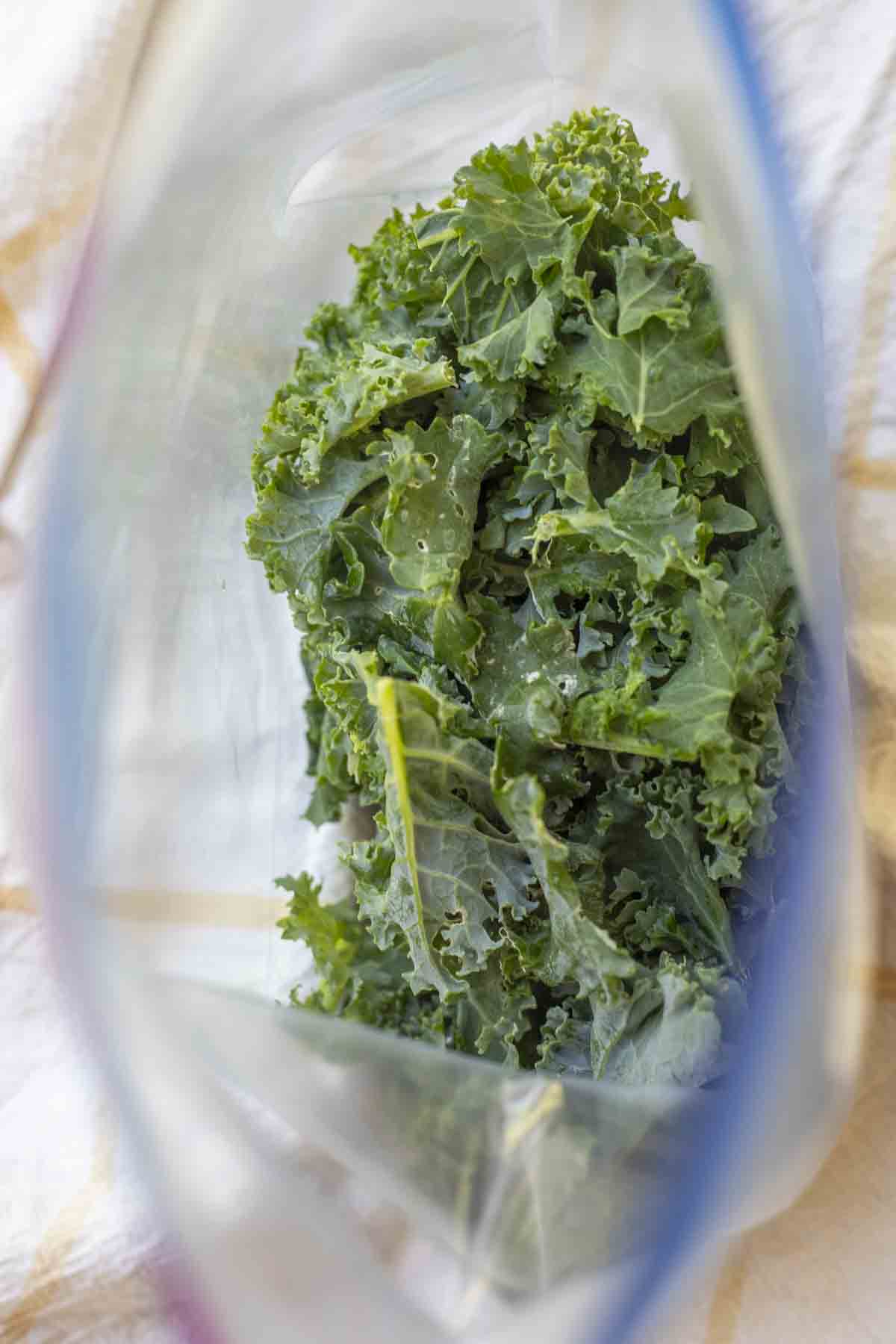Think you can’t enjoy fresh, nutritious kale all year round?
Think again!
Freezing kale is a simple yet effective way to preserve this leafy green and have it on hand when you need it most.
Whether you prefer to blanch it or freeze it raw, the possibilities are endless.
From hearty soups to vibrant smoothies, find out how freezing kale can be your secret to year-round culinary creativity.
freezing kale
Yes, kale can be frozen.
It is recommended to blanch the kale before freezing to stop ripening enzymes and keep the leaves fresh.
Blanching kale before freezing can extend its shelf life up to 1 year in the freezer.
To freeze kale, wash, de-stem, and chop the leaves.
Blanch the leaves in boiling water for 2 ½ minutes, then place in ice water for the same amount of time.
Drain and squeeze excess water.
Freeze small clumps of kale on a cookie sheet before transferring to a freezer bag.
Ensure to remove air from bags before sealing or use a vacuum sealer system.
Frozen kale can be used in smoothies, sautéed with rice vinegar or garlic, added to quiches, stews, and soups, or creamed for a treat.
Key Points:
- Kale can be frozen to extend its shelf life for up to 1 year in the freezer.
- Blanching kale before freezing is recommended to maintain freshness.
- To freeze kale, wash, de-stem, and chop the leaves.
- Blanch the leaves in boiling water for 2 ½ minutes, then place in ice water for the same amount of time.
- Drain and squeeze excess water.
- Freeze small clumps of kale on a cookie sheet before transferring to a freezer bag, ensuring to remove air before sealing.
freezing kale – Watch Video
💡
Pro Tips:
1. Freezing kale helps to break down the tough cell walls, making it easier to digest and increasing its nutritional availability.
2. During the freezing process, kale’s natural sugars become more concentrated, giving it a slightly sweeter flavor.
3. Freezing kale preserves its vitamin C content, ensuring that you still receive a healthy dose of this important nutrient.
4. Contrary to popular belief, freezing kale does not significantly affect its fiber content, making it a great option for adding dietary fiber to your meals even in its frozen state.
5. While frozen kale may not retain its crisp texture after thawing, it can still be used in a variety of dishes such as soups, stews, smoothies, or sautés, adding a nutritious punch to your culinary creations.
Freezing Kale Without Blanching: Use Within 4 Weeks
Freezing kale without blanching is a quick and convenient method to preserve this leafy green vegetable. However, it is important to note that frozen kale should be used within four weeks to ensure its optimal quality and flavor. While this method may not maximize the longevity of frozen kale, it is a great option for those who plan on using it relatively soon.
Blanching Kale For Fresh, Frozen Leaves
Blanching kale before freezing is a technique that offers several advantages:
-
Halts ripening enzymes: Blanching helps to halt the ripening enzymes in the leaves of kale. This step keeps the kale fresh and vibrant, even after it has been frozen.
-
Preserves nutritional value: The blanching process also preserves the nutritional value of kale. It ensures that the valuable nutrients in the leaves are retained during the freezing process.
-
Extended storage times: By blanching kale, you can extend its storage time. Blanched kale can last up to one year in the freezer, allowing you to stock up on this nutritious vegetable and have it available throughout the year.
In conclusion, blanching kale before freezing is an excellent option for anyone who wants to enjoy the benefits of this nutritious vegetable for an extended period of time.
Blanched Kale Can Last Up To 1 Year In Freezer
When it comes to preserving kale for extended periods, blanching is the key. By blanching kale leaves before freezing, you can ensure that they stay fresh and retain their nutritional value for up to one year in the freezer. This makes it a great option for those who want to have a stock of kale readily available throughout the year.
Prep Steps: Wash, De-Stem, And Chop Kale Leaves
Before freezing kale, it is crucial to complete the necessary prep steps to ensure quality results. Here is a step-by-step guide:
-
Wash the kale leaves: Start by thoroughly washing the kale leaves to remove any dirt or debris. This step is important to ensure that your frozen kale remains clean and safe to eat.
-
De-stem the leaves: Once the leaves are clean, it’s time to de-stem them. This can be done by either cutting or tearing the leaves away from the thick stems. Removing the stems will help improve the texture and taste of the frozen kale.
-
Chop the kale leaves: After de-stemming, chop the kale leaves into the desired size. Consider how you plan to use the frozen kale in future dishes. Smaller pieces are suitable for adding to soups or smoothies, while larger pieces can be used for sautéing or steaming.
By following these steps, you can ensure that your kale maintains its quality and freshness when frozen.
- Wash the kale leaves thoroughly
- De-stem the leaves by cutting or tearing them away from the thick stems
- Chop the kale leaves into the desired size
“Before freezing kale, it is crucial to complete the necessary prep steps to ensure quality results.”
Blanching Process: Boiling Water And Ice Water
Blanching kale is a simple process that helps to preserve its freshness.
To blanch kale, follow these steps:
- Prep the kale leaves by washing and removing any tough stems or ribs.
- Bring a pot of water to a rolling boil.
- Add a couple of handfuls of kale leaves at a time, making sure they are fully submerged in the boiling water.
- Cover the pot and blanch the kale for approximately 2 ½ minutes. If including the stems, extend the blanching time to three minutes.
- Remove the leaves and stems from the pot using tongs or a strainer.
- Immediately transfer them to a bowl of ice water.
- Let the kale sit in the ice water for the same amount of time as it was blanched.
Remember, blanching kale is a great technique for preserving its freshness while still keeping its vibrant color and nutritional value.
Drain And Squeeze Excess Water From Kale Leaves
After blanching the kale leaves and stems, it is essential to drain and remove excess water before freezing. Using a strainer, transfer the blanched kale leaves from the ice water bath and allow them to drain. Gently squeeze the leaves to remove any remaining water, ensuring they are as dry as possible. Properly draining and squeezing the excess water will prevent ice crystals from forming on the leaves, which can potentially affect their quality during freezing and thawing.
- Drain the blanched kale leaves using a strainer
- Gently squeeze the leaves to remove any remaining water
“Properly draining and squeezing the excess water will prevent ice crystals from forming on the leaves, which can potentially affect their quality during freezing and thawing.”
Freeze Kale In Small Clumps On A Cookie Sheet
To freeze kale, it is recommended to freeze it in small clumps rather than in a large batch. This allows for easier portioning and use in future recipes.
Begin by arranging the drained and squeezed kale leaves into small clumps on a lined cookie sheet. Ensure that the clumps are not touching to avoid them freezing together.
Place the cookie sheet in the freezer, allowing the kale to freeze until firm. This step prevents the clumps from sticking together and makes it easier to transfer them to freezer bags later on.
Proper Storage: Removing Air From Freezer Bags
After freezing the kale on the cookie sheet, transfer the clumps to freezer bags for long-term storage. It is crucial to remove as much air as possible from the bags to prevent freezer burn and maintain the quality of the kale.
Two options for removing air from the bags are:
- Use a vacuum sealer system to completely remove the air.
- Alternatively, manually remove the air by gently pressing on the bag as you seal it.
Properly sealed bags will help maintain the taste, color, and texture of the frozen kale.
- Transfer frozen kale to freezer bags.
- Remove as much air as possible.
- Use a vacuum sealer or manually press on the bag to remove air.
Creative Uses For Frozen Kale In Recipes
Frozen kale is a versatile ingredient that can be incorporated into various recipes, allowing you to enjoy the nutritious benefits of this vegetable throughout the year. Here are some ways you can use frozen kale:
-
Smoothies: Add frozen kale to your morning smoothies to give them a boost of vitamins and minerals.
-
Sautéed Side Dish: Sauté frozen kale with seasoned rice vinegar or garlic to create a flavorful side dish. This can also be used as a base for stir-fries.
-
Quiches, Stews, and Soups: Add frozen kale to quiches, stews, and soups to enhance both the flavor and nutritional content of the dishes.
-
Creamed Kale: Transform frozen kale into a delightful and nutritious creamy side dish that pairs well with any meal.
-
Pesto: Use frozen kale to make a delicious and healthy pesto sauce, giving a unique twist to your pasta or other dishes.
Remember, frozen kale is a convenient and accessible option that can be enjoyed year-round. Try out these ideas to incorporate it into your meals and reap the benefits of this nutritious vegetable.
Blanching Greens For Fresh, Non-Bitter Taste
The process of blanching greens, such as kale, offers multiple benefits beyond preservation. Blanching stops the ripening enzymes in the leaves, ensuring that they remain fresh and vibrant.
One significant advantage is that it helps prevent the development of a bitter taste that can occur in greens when they are stored or cooked. By blanching kale, you can enjoy its natural flavors without any unpleasant bitterness, making it an ideal option for those who prefer a milder taste.
- So, to summarize the benefits of blanching kale:
- Retains freshness and vibrancy
- Prevents development of bitter taste
- Enhances natural flavors
In conclusion, whether you choose to freeze kale without blanching or opt for the blanching method, it is essential to consider the desired storage period and nutritional preservation. Freezing kale allows for year-round availability of this nutritious leafy green, ensuring you can reap its many health benefits in various culinary creations.
So, follow the steps outlined in this ultimate guide to freezing kale, and enjoy the convenience and versatility of this vibrant veggie all year long.
💡
You may need to know these questions about freezing kale
What is the best way to freeze kale?
The ideal method to freeze kale would be to blanch it before freezing. Blanching the kale helps retain its color and flavor. To do this, bring a pot of water to a boil and quickly submerge the kale leaves for 2-3 minutes. Once blanched, transfer the kale to an ice bath to halt the cooking process and then pat dry. Finally, store the kale in freezer-safe bags or containers for later use. Taking these steps will ensure that your frozen kale maintains its vibrancy and taste when you’re ready to use it.
Does kale stay good in the freezer?
Yes, kale can be stored in the freezer and will remain fresh for up to six months. After ensuring that the kale is completely dry, it should be spread in a single layer on a baking sheet and flash frozen for at least three hours or overnight. Once frozen, transfer the kale to a labeled freezer-safe bag and store it in the freezer. This method allows for a convenient and extended storage of kale, ensuring that it stays good for an extended period of time.
How do you freeze a bag of kale?
To freeze a bag of kale, start by thoroughly rinsing the kale and allowing it to drain thoroughly. Once drained, transfer the kale into an airtight freezer-safe container, such as a freezer bag. Freezer bags are particularly convenient as they can be stored flat, minimizing the space they occupy in the freezer.
How do you store kale in the freezer for smoothies?
To store kale in the freezer for smoothies, start by blanching the kale and drying it thoroughly using a salad spinner or paper towels. Once dry, lay the kale leaves flat on a rimmed baking sheet and freeze them until they are solid, which typically takes 1 to 2 hours. Afterward, transfer the frozen kale leaves into a freezer bag and store them in the freezer for up to 8 months. This process ensures that the kale maintains its freshness and nutritional value, making it convenient for future use in your delicious smoothies.
Reference source
https://soilborn.org/recipe/how-to-freeze-kale/
https://whatmollymade.com/how-to-freeze-kale/
https://www.allrecipes.com/article/how-to-store-kale/
https://www.budgetbytes.com/how-to-freeze-kale/



